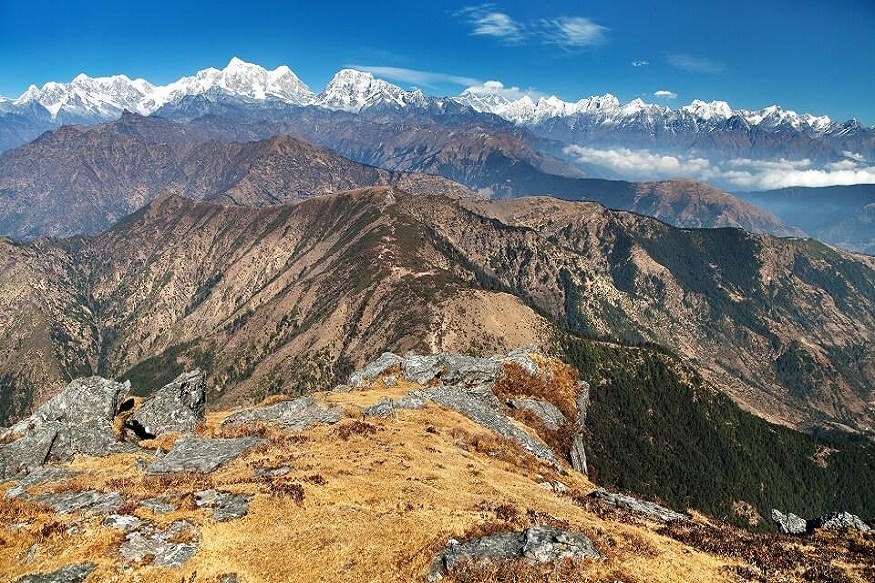The Pikey Peak Trek is a breathtaking trekking route in Nepal that offers stunning views of the world’s highest peaks, including Mount Everest. This lesser-known trail is perfect for trekkers looking for a quieter and more off-the-beaten-path adventure while still experiencing the beauty of the Himalayas.
Why Choose Pikey Peak Trek?
Pikey Peak is considered one of the best viewpoints in Nepal, offering panoramic views of eight of the world’s highest mountains, including Everest (8,848m), Kanchenjunga (8,586m), Lhotse (8,516m), and Makalu (8,485m). The trek is famous for its sunrise and sunset views, which are said to be some of the best in the entire Himalayan range.
Best Time to Trek
The best time to trek to Pikey Peak is during the spring (March to May) and autumn (September to November). These seasons provide clear skies, moderate temperatures, and excellent visibility of the mountains. Winter (December to February) is also possible, but the cold can be extreme, while the monsoon season (June to August) brings heavy rainfall and slippery trails.
Trekking Route and Itinerary
The trek typically starts from Dhap or Jiri, which are accessible by road from Kathmandu. The standard itinerary lasts about 5 to 7 days, covering scenic villages, lush forests, and Buddhist monasteries. The highlight is reaching the summit of Pikey Peak (4,065m), where trekkers are rewarded with a 360-degree panoramic view of the Himalayas.
Difficulty Level
Pikey Peak Trek is considered a moderate trek. It does not require prior trekking experience, making it an excellent option for beginners. However, trekkers should be prepared for long walking hours and some steep ascents.
Cultural and Natural Beauty
One of the most enriching aspects of the trek is the opportunity to experience the Sherpa culture. The region is dotted with ancient Buddhist monasteries, chortens, and prayer flags. The trail also passes through beautiful rhododendron forests, yak pastures, and traditional mountain villages, offering a glimpse into the local way of life.
Nepal Indigenous Trail Trek: A Cultural and Natural Wonderland
Introduction
The Nepal Indigenous Trail Trek is a unique trekking experience that takes travelers through the culturally rich and less-explored regions of Nepal. Unlike the popular trekking routes such as the Everest Base Camp or Annapurna Circuit, this trail offers an immersive experience of Nepal’s indigenous communities, their traditions, and breathtaking landscapes. This trek is ideal for those who seek a blend of adventure and cultural exploration.
Highlights of the Trek
-
- Cultural Immersion: The trek passes through indigenous villages inhabited by the Tamang, Sherpa, Newar, and Tharu communities. Travelers get an opportunity to experience their unique traditions, language, and way of life.
- Scenic Landscapes: From terraced fields to dense forests and panoramic mountain views, the trail offers a diverse range of natural beauty.
- Less Crowded Path: Unlike commercial trekking routes, the Indigenous Trail provides a peaceful and authentic experience away from mass tourism.
- Homestay Experience: Staying in local homes instead of commercial lodges allows trekkers to engage deeply with the local people and enjoy authentic Nepali cuisine.
- Everest Base Camp (EBC) trek without taking a flight to Lukla is possible and follows a more traditional route used before the Lukla airport was built. This option avoids the sometimes unreliable and risky Lukla flights and allows for a gradual acclimatization. Here’s how you can do it:
-
Alternative Route to EBC Without a Lukla Flight
- Instead of flying from Kathmandu to Lukla, you start your trek from Jiri or Salleri, which adds about 5-7 days to the standard EBC trek.
Best Time to Trek
- Spring (March-May): Best weather, blooming rhododendrons.
- Autumn (September-November): Clear skies, best mountain views.
- Winter (December-February): Very cold, but fewer crowds.
- Monsoon (June-August): Rainy, leeches, not recommended.
The Everest base camp trek without flight to lukla is a great alternative if you want to avoid Lukla’s flights and experience a traditional trekking route. Let me know if you need an itinerary or more details!

